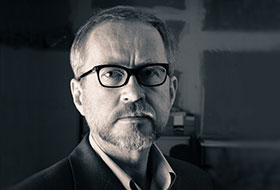Bruno Griesel
Artworks
Biography
Exhibitions
About the artist
 |
Since studying drawing and painting at the Academy of Visual Arts in Leipzig in the 1980s with the teachers Volker Stelzmann, Wolfgang Peuker and Bernhard Heisig, Griesel has developed a naturalistic and figurative style of painting. He discovered a love for Baroque painting and the genres (Biblical history, devotional paintings, portraits), themes and motifs associated with it. Powerful sentiments and a melting colourfulness are the artistic values of the age that fascinate Griesel so much. A further source of inspiration for the development of mythological themes is offered by what Winkelmann calls the Eclecticists or Renaissancists of early 17th century Bologna and Venice. And yet, the incunabula of the avant-garde also inspire him to experiment in painting: music, rhythm and dynamics are linked with imaginary geometric or abstract shapes and a cognitive colourfulness, and open wide frames of reference in which »everything« can stand for »everything else«. With his painted black square in 1916/18, Kazimir Malevich established the beginnings of a new direction in art, Suprematism. This radical reduction of painting to form and colour is still regarded today as a signpost to the renewal of art and society and an icon of modernism. Griesel repeatedly makes reference in his pictures to the specific function of abstract painting as an icon and a medium of prayer: that is, the silent dialogue between the observer and the representative of the divine. Griesel places his symbols and subjects against the backdrop of the history of avant-garde art, thereby creating an exciting synthesis of abstract figuration and figurative abstraction. His intensive struggle with the incunabula of art history and their apperceptive translation into his work is an example of the typical Leipzig form of traditionalism, whose mysteriousness repeatedly presents new challenges to the observer. In Griesel‘s vibrantly coloured and yet sensitive representations of landscapes, women (dancers) and couples, it is not a question of the individual characterisation of the figures. Rather, they are representatives of an intellectual position, the expression of the composition, which show in their design the simplification and typification of the figurative form in, for example, elements of dance and movement. The mythological and Biblical backdrops against which the figures appear are, as it were, an aid to the painter‘s (and the recipient‘s) sensual-moral analysis, the result of which often appears as a mischievous pleasure in atmospheres, beauty and decor. Asked about his conception of painting, Picabia answered, »It consists in forgetting about it and regarding it as an optical pleasure, since in my opinion everything is decorative.« Many paintings by Picabia therefore seem like photographs with cross-fading, which hedonistically examine art history from every angle, without particular preference, apart from for naked female bodies or lovers. If not quite as radical as this, one frame of reference for looking at Griesel‘s works is linked with the notions of kitsch and eclecticism. It is therefore astonishing that, in spite of all of the reflections on modernism and anti-modernism and an awareness of the heritage of painting, an artist of the young generation and the New Leipzig School like Griesel ends up once again with a fascination for painting. (Thorsten Hinz, Art historian and critic, Leipzig)
|